#solar atmosphere
Explore tagged Tumblr posts
Text
"In a new study published in The Astrophysical Journal, a researcher from The University of Alabama in Huntsville (UAH), a part of the University of Alabama System, explores critical aspects of a phenomenon called kinetic Alfvén waves (KAWs) to provide fresh insights into an age-old heliophysics mystery.
Syed Ayaz, a graduate research assistant at the UAH Center for Space Plasma and Aeronomic Research (CSPAR), examined the potentially pivotal role of KAWs in heating the solar corona, moving science one step closer to solving the puzzle of why the corona is many times hotter than the surface of the sun itself.
"For decades, Alfvén waves have been proven to be the best candidates for transporting energy from one place to another," Ayaz says, noting the potential role of KAWs in driving coronal heat.
"This paper utilizes a novel approach to model energetic particles in space plasmas, as observed by satellites like Viking and Freja, to answer how the electromagnetic energy of the waves, interacting with particles, transforms into heat during the damping process as the waves move through space."
"The corona, or solar atmosphere, is an enigmatic region surrounding our home star that extends far beyond the visible disk of the sun, stretching some 8 million kilometers above the sun's surface. Yet, the corona is also characterized by extraordinarily high temperatures, a mystery that has captivated astrophysicists for nearly seventy years."
continue reading
#sun#magnetism#electromagnetism#plasma#energy#matter#temperature#solar energy#corona#sun surface#astronomy#space#star#solar system#solar atmosphere#magnetic field#waves#frequency#energy transference
20 notes
·
View notes
Text
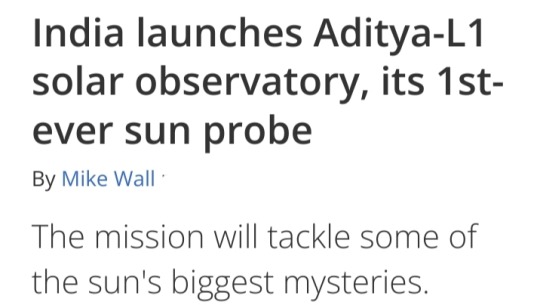
2 September 2022
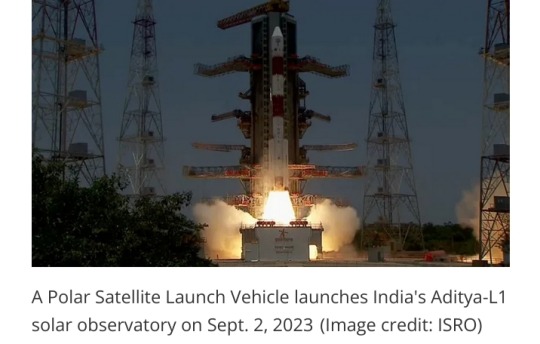
Fresh off its success at the moon, India is now headed for the sun.
The nation launched its first-ever solar observatory today (Sept. 2), sending the Aditya-L1 probe skyward atop a Polar Satellite Launch Vehicle (PSLV) from Satish Dhawan Space Centre at 2:20 a.m. EDT (0620 GMT; 11:50 a.m. local India time).
The PSLV deployed Aditya-L1 into low Earth orbit (LEO) as planned about 63 minutes after liftoff, sparking applause and high fives in mission control.
"Congratulations, India, and congratulations, ISRO [the Indian Space Research Organisation]," Jitendra Singh, India's Minister of State for Science and Technology, said shortly after deployment on ISRO's launch webcast.
"While the whole world watched this with bated breath, it is indeed a sunshine moment for India," Singh added.
The successful launch followed on the heels of another big milestone for India: On August 23, its Chandrayaan-3 mission became the first to land softly near the moon's south pole.
Chandrayaan-3's lander-rover duo are expected to conk out in a week or so, when the harsh lunar night falls at their touchdown site. But Aditya-L1's long journey has just begun.
A long road to a good sun-viewing spot
Aditya-L1 won't stay in LEO forever:
After a series of checkouts, it will use its onboard propulsion system to head toward Earth-sun Lagrange Point 1 (L1), a gravitationally stable spot about 1 million miles (1.5 million kilometers) from our planet in the direction of the sun.
That destination explains the latter part of the mission's name. And the first part is simple enough: "Aditya" translates to "sun" in Sanskrit.
The 3,260-pound (1,480 kilograms) observatory will arrive at L1 about four months from now, if all goes according to plan.
But the long trek will be worth it, according to the ISRO.
"A satellite placed in the halo orbit around the L1 point has the major advantage of continuously viewing the sun without any occultation/eclipses," ISRO officials wrote in an Aditya-L1 mission description.
"This will provide a greater advantage of observing the solar activities and its effect on space weather in real time."
Indeed, another sun-studying spacecraft is already at L1 — the Solar and Heliospheric Observatory (SOHO), a joint NASA-European Space Agency mission that launched in December 1995.
(Several other spacecraft, including NASA's James Webb Space Telescope, are at Earth-sun Lagrange Point 2, which is a million miles from Earth, in the direction away from the sun.)

Solar flares, the coronal heating mystery and more
Once it's settled in at L1, the solar probe will use four three science instruments to study the particles and magnetic fields in its immediate surroundings and four others to scrutinize the sun's surface (known as the photosphere) and its atmosphere.
This work will help scientists better understand solar activity, including the dynamics of solar flares and coronal mass ejections (CMEs), ISRO officials say.
Flares are powerful flashes of high-energy radiation, and CMEs are huge eruptions of solar plasma.
Both types of outburst can affect us here on Earth. Intense CMEs that hit our planet, for example, trigger geomagnetic storms that can disrupt satellite navigation and power grids.
(As a side benefit, such storms also supercharge the gorgeous light shows known as auroras.)
Aditya-L1 will also tackle the "coronal heating problem," one of the biggest mysteries in heliophysics.
The corona — the sun's wispy outer atmosphere — is incredibly hot, reaching temperatures around 2 million degrees Fahrenheit (1.1 million degrees Celsius), according to NASA.
That's about 200 times hotter than the solar surface, which is "only" 10,000 degrees F (5,500 degrees C) or so.
It's still unclear what is responsible for this startling and counterintuitive discrepancy.
(Why would it be hotter away from the sun's core, where the energy-producing nuclear fusion reactions are occurring?)
Aditya-L1 has other science goals as well. For instance, the mission also aims to more fully flesh out the solar wind, the stream of charged particles flowing constantly from the sun, ISRO officials said.
Aditya-L1 will measure the composition of the solar wind and attempt to determine how it is accelerated.
And Aditya-L1 will do all this work on the cheap:
The mission's price tag is about 3.8 billion rupees, or $46 million US at current exchange rates.
That's in the same ballpark as Chandrayaan-3
India's first successful moon-landing mission costs about 6.15 billion rupees, or $74 million US.
For comparison, NASA's most recent big-ticket sun mission, the record-setting Parker Solar Probe, costs roughly $1.5 billion.
This disparity should not be viewed as an indictment of NASA, however; labor costs are much higher in the United States than in India, among other differences between the two nations' economies.
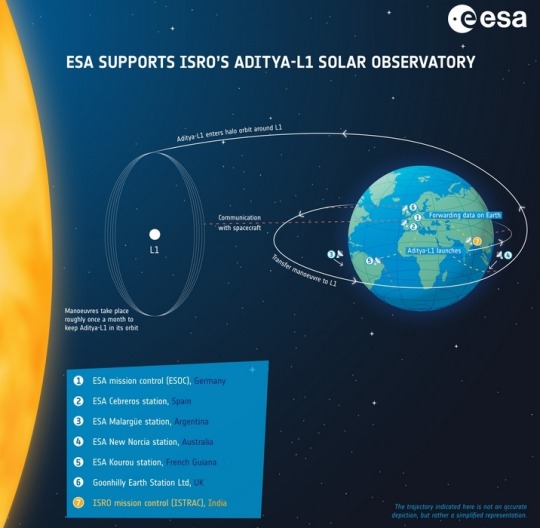
Aditya-L1 is a coronagraphy spacecraft to study the solar atmosphere, designed and developed by the Indian Space Research Organisation (ISRO) and various other Indian research institutes.
#India#Aditya-L1#Polar Satellite Launch Vehicle (PSLV)#Satish Dhawan Space Centre#low Earth orbit (LEO)#sun#Indian Space Research Organisation#Chandrayaan-3#Earth-sun Lagrange Point 1 (L1)#Solar and Heliospheric Observatory (SOHO)#solar flares#coronal mass ejections (CMEs)#coronal heating problem#heliophysics#solar wind#Parker Solar Probe#NASA#solar observatory#solar atmosphere
13 notes
·
View notes
Video
youtube
সূর্যের শক্তি উৎপাদনের পেছনে কি রহস্য লুকিয়ে?
#youtube#সূর্যের শক্তির উৎস#নিউক্লিয়ার ফিউশন#হাইড্রোজেন থেকে হিলিয়াম#প্রোটন-প্রোটন চক্র#সূর্যের কেন্দ্র#সৌর তাপ এবং আলো#সৌর বিকিরণ#শক্তি স্থানান্তর#প্লাজমা অবস্থা#সৌর বায়ুমণ্ডল#গ্র্যাভিটেশনাল চাপ#সূর্যের জীবন চক্র#থার্মো নিউক্লিয়ার বিক্রিয়া#সূর্যের অভ্যন্তরীণ প্রক্রিয়া#Source of solar energy#Nuclear fusion#Hydrogen to helium conversion#Proton-proton chain#Core of the Sun#Solar heat and light#Solar radiation#Energy transfer#Plasma state#Solar atmosphere#Gravitational pressure#Sun's life cycle#Thermonuclear reaction
0 notes
Text
🌞 Prepare to be mesmerized as Aditya-L1, India's remarkable space mission, captures a breathtaking selfie and stunning images of our home planet Earth and the serene Moon! 🚀
ISRO's Aditya-L1 is on a mission like no other, headed for the Sun-Earth L1 point to study the Sun. But it's also treating us to a spectacular visual treat along the way.

#isro#adityal1#Aditya-L1#Sun-Earth L1 Point#Solar Selfie#Earth#Moon#Space Mission#Space Exploration#ISRO#Solar Activities#Space Weather#Payloads#Solar Atmosphere#Coronal Heating#Solar Dynamics#Solar Flares#Coronal Mass Ejections#Solar Research#Solar Corona#Solar Wind#Magnetic Field#Space Science#Science Discovery.#chandrayan#aditya l1
1 note
·
View note
Text

Earth is such a beautiful planet
#astronomy#nasa#astronomers#universe#nasa photos#astrophotography#astrophysics#outer space#nasawebb#hubble space telescope#earth pics#beautiful earth#mother earth#earthlings#planet earth#earth#space exploration#space#science#james webb space telescope#space travel#solar system#i love astronomy#astronomy facts#nasaastronaut#nasa science#planetary science#planetary nebula#atmosphere#nasa picture of the day
857 notes
·
View notes
Text

There is a giant hexagon, larger than Earth, at Saturn’s north pole. It’s a permanent jet stream with hurricane-like storms swirling inside.
167 notes
·
View notes
Text
A severe solar storm sparked by an intense flare from the sun could reach "extreme" levels as it bombards Earth, officials with the U.S. National Oceanic and Atmospheric Administration (NOAA) warned on Thursday (Oct. 10). Scientists with NOAA's Space Weather Prediction Group (SWPC) said that a cloud of charged solar material, called a coronal mass ejection, slammed into Earth around midday, triggering a "severe" geomagnetic storm that could impact power grids and GPS and radio communications systems, as well as amplify aurora displays in regions that typically don't see them.
Continue Reading.
#Science#Space#Astronomy#Sol#Solar Storm#Solar Flares#Northern Lights#Auroras#NOAA#National Oceanic and Atmospheric Administration
134 notes
·
View notes
Text
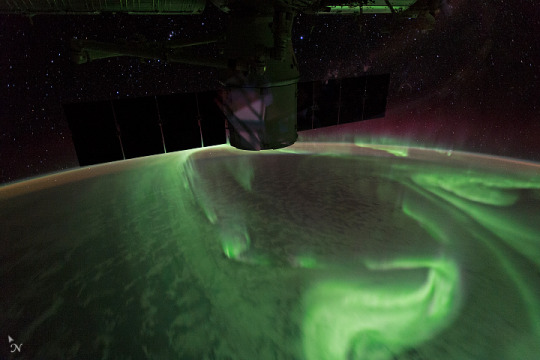
An astronaut took this photograph of the Aurora Australis in August 2017. At the time, the International Space Station was moving over the southern Indian Ocean towards the Great Australian Bight and Melbourne, Australia.
#aurora#auroras#aurora australis#southern lights#stars#solar wind#solar winds#earth#space#orbit#magnetosphere#atmosphere#atmospheric phenomena#nasa#science#international space station#indian ocean#great australia bight#melbourne#australia#2017#2010s
188 notes
·
View notes
Photo

nasa: A stone cold look at Saturn 🗿
The giant planet gives us a look into its moody disposition. The Cassini spacecraft captured this image on Jan. 30, 2007, from a distance of 700,000 miles (1.1 million kilometers). As Saturn’s atmosphere rages with thunderous and hurricane-like storms, its majestic rings spin a tale of ancient collisions and cataclysms. A joint endeavor of NASA, @europeanspaceagency, and @agenziaspazialeitaliana, Cassini was a sophisticated robotic spacecraft sent to study Saturn and its complex system of rings and moons over the course of a decade. Lessons we took from Cassini helped in the planning of our #EuropaClipper mission, which is on its way to Jupiter and expected to arrive in April 2030. Image description: A black-and-white image of Saturn taken from a lower angle. The rings of Saturn frame the upper right portion of the planet in various widths. Details of stripes and swirls from storms can be seen along the face of the planet. The left side of the planet is encompassed in a shadow. Credit: NASA/JPL-Caltech/Space Science Institute #NASA #Space #Saturn #Rings #Storms #Atmosphere #Moody #Planet #SolarSystem #BlackAndWhite
#nasa#esa#asi#space#saturn#cassini#jpl#jpl-caltech#cal tech#space science institute#planet#rings#storm#atmosphere#solar system#astronomy#space exploration#2007#january 30
26 notes
·
View notes
Text
#Andrew McCarthy#astronomy#solar photography#sun#solar flare#sun's atmosphere#sol#religion is a mental illness
20 notes
·
View notes
Text
"NOAA today shared the first images from the Compact Coronagraph (CCOR-1), a powerful solar telescope onboard the new GOES-19 satellite. CCOR-1, the world's first operational, space-based coronagraph, began observing the sun's corona, the faint outermost layer of the solar atmosphere, on September 19, 2024."

(Credit: NOAA Headquarters)
"CCOR-1 monitors the corona to forecast coronal mass ejections (CMEs), which are large expulsions of plasma and magnetic fields from the sun that can produce space weather impacts on Earth."
Video
continue reading
#sun#solar system#energy#radiation#astronomy#space#universe#plasma#magnetism#electromagnetism#corona#solar energy#space weather#solar atmosphere#magnetic field#earth atmosphere#stars#earth#cosmology#science
9 notes
·
View notes
Text

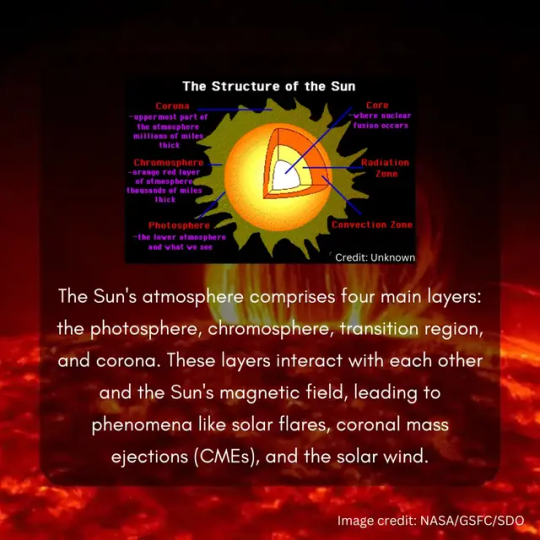
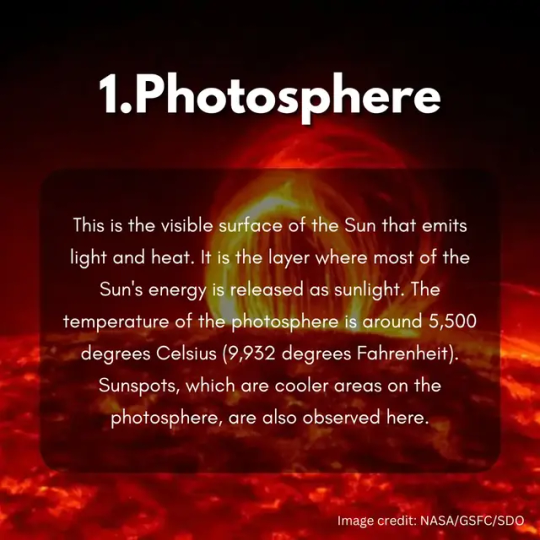
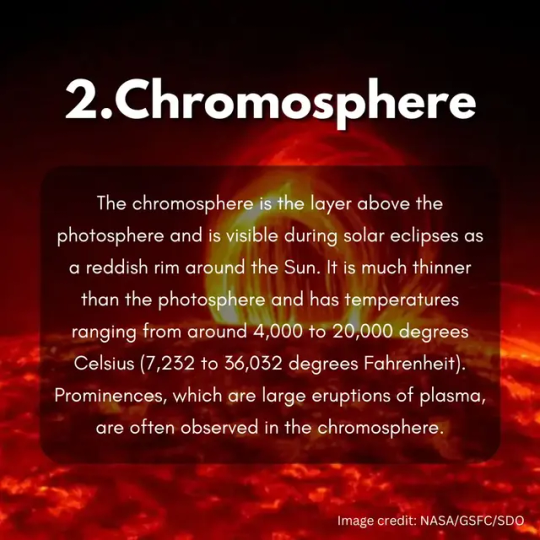



Sun's not all fire! 🌞 It's got a 4-layer atmosphere of scorching plasma. Corona's the hottest, millions of degrees! Read through to know more about these layers.
#sun#solar#solar energy#atmosphere#chromosphere#astroblr#astronomers#physics#celestial#galaxy#astrophysics#astronomy#astrophotography#astro community#cosmic#cosmos#cosmology#space science#space#solar system#solar eclipse#science#science facts#education#discover#scicomm#study blog#study blr#explore#simps for science
62 notes
·
View notes
Note
Beloved Seren!! I'm curious about if you have theories/predictions about MC's condition, like from an astronomy point of view? You mentioned that you view how the energy comes and goes kind of like solar flares! And I've been predicting that the powers being too much for the MC to survive would be sort of like they were turned into a dying star...but I know like 0.1 astronomy thing and only for fic purposes lol. So I'm curious if you have an opinion/perspective/prediction on what is happening to MC? (I'm not sure if my question even makes sense and zero pressure at all to answer this haha ❤️ I just figured you would have a cool perspective on it!!)
Lovely PD, thank you for the ask <3 This is a very good question and I have been thinking about Li-Sar and the MC's power, but my theories are somewhat fuzzy.
First, the theory that is related to my comment about solar flares. One of the things that caught my attention was how often the demo mentions electricity in regard to Li-Sar's powers, while also mentioning their power is "solar magic". This made me think about the Sun's magnetic field lines, because the Sun's electric currents and magnetic field are linked closely together. Because of turbulence of the Sun's plasma, those magnetic field lines get all tangled up. This can lead to them breaking and connecting with others, a process that releases a burst of energy (magnetic reconnection, see v cool video here, though the image below is clearer), accelerating particles, and causing bursts of electromagnetic radiation: solar flares.
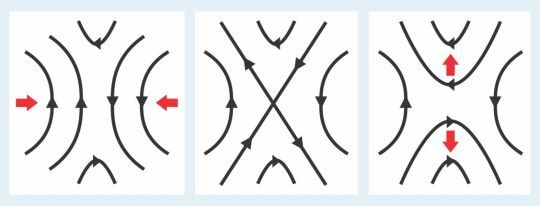
The radiation sickness, together the mentions of Li-Sar---and now the MC---wields solar radiation, fit with the idea of solar flares. Only it seems Li-Sar can control this, while we see that the MC cannot. Looking at Li-Sar's comment on how a human body won't be able to handle the building magic, my theory would be that the "flares", like that burst of power in chapter 2, will get stronger and more frequent, eventually tearing the MC apart. It wouldn't be the radiation itself, as that doesn't seem to be an issue so far, but rather the energy involved in powering those bursts. Obviously, I assume a solution will be found.
My second theory fits with you say about a dying star, because it could be like a supernova event! A supernova type Ia is what comes to mind, with a white dwarf (the MC) and a companion star (Li-Sar). The MC siphoned mass (this power) from Li-Sar, causing them to cross a certain threshold, which then leads to the explosion/death.
And another theory that no one asked for, but Li-Sar reminds me of an O or B type star, as they are blueish-white, fitting with the blue and white colour scheme that keeps popping up in the demo. These stars have masses between ~3 - 200 times the mass of the sun, so like Ostin said, they have the power of "a dozen suns" or even more.
Such high mass stars can end in supernova explosion without the need for a companion star. Ignoring ethical considerations and the canon lore behind the Agency not killing supernaturals, this might be a reason the Agency didn't kill Li-Sar. Their death might cause so much destruction and make the planet uninhabitable. But that's just me being speculative.
#seren talks astronomy#twc book 4 demo#thank you for letting me ramble about astronomy <3333#ehm.. i hope this sort of answered your question?#i certainly talked a lot haha#i am trying to stick with things Mishka might have found#and the magnetic reconnection seems a bit far-fetched#but solar flares/winds are pretty well-known#and those high energy particles that are thrown out *can* cause radiation sickness#although the earth's atmosphere and magnetosphere protect us here <3#hmmm this leads me to wonder if electromagnetism will somehow be involved in defeating Li-Sar?#the wayhaven chronicles
18 notes
·
View notes
Note
Some Ruby sketches (I just recently started learning how to draw, have mercy on me🙏), def did not basically make a self portrait bc who DOESN'T want a slowburn romance with that man😭



THIS IS SO CUTE I’M DYING!!!! just the fact that someone took their time to sketch a character from my fic is INSANE!!!! 😭😭😭😭 also don’t worry about her appearance, ruby is a self insert she’s SUPPOSED to look like you 😭😭😭 THANK YOU SO MUCH!!!!!!!
#fic:aurora#solar-atmosphere#ask#never in my life would i imagine that people would want to make art of my fics???#this is insane#im usually insane abt my stories and i love to know that poeple are a bit insane for them too 😭😭🙏
10 notes
·
View notes
Text

Starship Flight 7 BROKE up during re-entry
#ive starship#stars#space x#starship#reentry#atmosphere#astronomy#nasa#astronomers#universe#nasa photos#astrophotography#outer space#astrophysics#nasawebb#hubble space telescope#musk#elon musk#space exploration#space#science#james webb space telescope#space travel#nasa science#science facts#planetary science#our universe#the universe#planetary nebula#solar system
290 notes
·
View notes
Text
Introduction to the Schumann Resonance
The Schumann Resonance is often described as the heartbeat of the Earth. It is named after physicist Winfried Otto Schumann, who predicted its existence in 1952. The Schumann Resonance is basically a set of electromagnetic waves that circle around the Earth outside the atmosphere, between the Earth's surface, and through the ionosphere. *the ionosphere is an atmospheric layer that contains charged particles* These waves resonate at specific frequencies, the main one being 7.83 Hz.
So why does this happen? Think of the space between the Earth's surface and the ionosphere as a drum. Lightning strikes, of which there are thousands happening all over the world at any moment, act like drumsticks, hitting the drum and creating sound. But instead of sound, these strikes create electromagnetic waves that bounce between the Earth and the ionosphere, creating the Schumann Resonance.
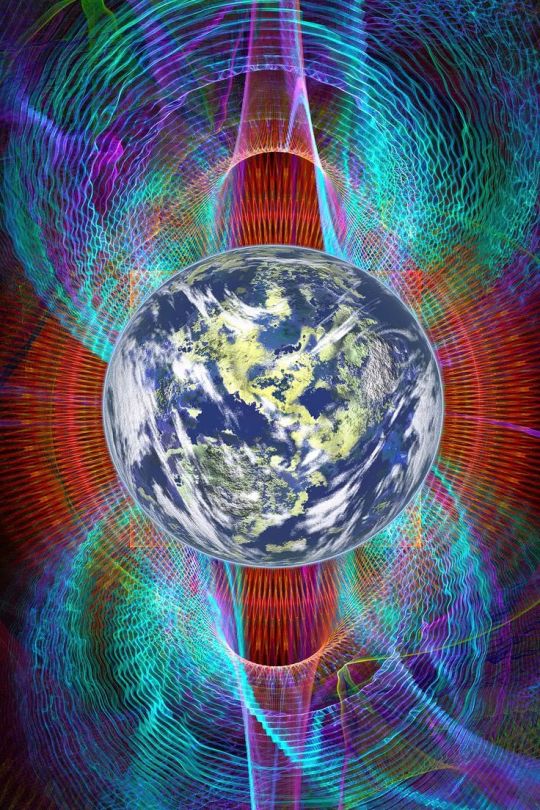
The Earth’s surface and the ionosphere form what’s called a resonant cavity. A resonant cavity is essentially a space where waves can bounce back and forth, reinforcing each other under the right conditions. In this case, the electromagnetic waves generated by lightning strikes travel through the cavity formed by the Earth's conductive surface and the ionosphere, reflecting off of each boundary.
This space between the surface of the Earth and the ionosphere is about 34 miles (or roughly 55 kilometers) thick, acting like the drumhead in the analogy. Because this cavity is relatively constant in size, it supports specific frequencies of electromagnetic waves, with 7.83 Hz being the dominant one due to the size and shape of the cavity. It’s similar to how a guitar string resonates at a certain pitch depending on its length and tension.
The fundamental frequency of 7.83 Hz is just one of several resonant frequencies. These frequencies, known as harmonics, occur because the cavity can support different "modes" of wave vibration. Beyond the fundamental mode, there are higher frequencies that resonate within this cavity as well, typically around 14.3 Hz, 20.8 Hz, 27.3 Hz, and 33.8 Hz. These harmonics exist because the electromagnetic waves can reflect and reinforce each other at multiples of the fundamental frequency.
The Role Of Lightning
Lightning is a crucial part of this entire process. With an estimated 2,000 thunderstorms occurring across the globe at any given moment, and around 50 lightning strikes happening each second, the atmosphere is constantly being charged with electromagnetic energy. Each lightning strike releases energy that generates these low-frequency electromagnetic waves, which propagate through the resonant cavity formed by the Earth and ionosphere.
This is why the Schumann Resonance is considered a global phenomenon—it depends on continuous electrical activity occurring all over the world. The energy from thunderstorms and lightning strikes drives the resonance, maintaining the standing waves that vibrate in this cavity. It is this constant electrical activity that sustains the resonance and gives rise to the steady, predictable frequencies we can measure.
The Ionosphere
The ionosphere, which forms the upper boundary of the resonant cavity, is a highly dynamic part of the Earth’s atmosphere. It’s composed of charged particles, or ions, that are created by the interaction of solar radiation (primarily ultraviolet and X-rays from the Sun) with the Earth’s atmosphere. The ionosphere plays a crucial role in reflecting the electromagnetic waves generated by lightning back toward the Earth's surface, allowing the Schumann Resonance to occur.
However, the ionosphere isn't static—it fluctuates with solar activity, time of day, and atmospheric conditions. During periods of high solar activity, such as solar flares or geomagnetic storms, the ionosphere can become more ionized, which alters its properties and can affect the Schumann Resonance frequencies. Changes in solar radiation or geomagnetic conditions can temporarily increase or decrease the frequencies at which the Schumann waves resonate, creating small variations in the resonance.
Measuring Schumann Resonance
Schumann Resonance is often measured using ground-based electromagnetic detectors that can pick up these low-frequency signals. Scientists use these measurements to study not only the global electrical activity but also the state of the Earth's atmosphere and ionosphere. The resonance can act as a natural indicator of atmospheric conditions and is sometimes referred to as an atmospheric barometer. For example, changes in the resonance can signal shifts in global lightning activity or disturbances in the ionosphere caused by solar events.
Through careful monitoring of Schumann Resonance, scientists can gain insights into global weather patterns, thunderstorms, and even how space weather—such as solar winds and geomagnetic storms—affects the Earth's atmosphere.
Global Relevance
Although the Schumann Resonance is a natural electromagnetic phenomenon, it has broader implications for how we understand the Earth’s electromagnetic environment. It is a reflection of the interaction between the planet's atmospheric system and external forces like solar radiation and cosmic influences. Because of this, studying the Schumann Resonance offers insights into not just weather and atmospheric science, but also how Earth’s environment reacts to changes in space weather.
Moreover, the study of Schumann Resonance helps scientists better understand how electromagnetic waves travel around the Earth, providing valuable data for radio communication systems and atmospheric research. This understanding is essential for improving communication systems that rely on bouncing radio waves off the ionosphere, such as long-distance communication systems.
#weather#atmosphere#science#scienceblr#studyblr#study blog#study motivation#studying#global activity#solar activity#sun#solar flare#schumann#electromagnetism#learning#education#education blog#interesting#fascinating#the more you know#geophysics#space#outer space#earth#meterology#electrical engineering#biophysics
12 notes
·
View notes